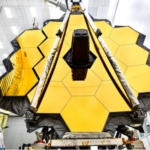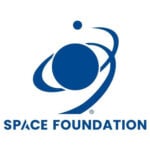Space Foundation Press Releases
Legendary Astronaut John Young to Receive Hill Award
Written by: developer
COLORADO SPRINGS, Colo. (Jan. 22, 2010) — The Space Foundation Board of Directors has selected former Gemini, Apollo, and Space Shuttle Astronaut Captain John Young, USN (Retired), for the Foundation’s highest honor – the General James E. Hill Lifetime Space Achievement Award. The award will be presented at a special luncheon event on Wednesday, April 14, 2010, during the 26th National Space Symposium at The Broadmoor Hotel in Colorado Springs, Colo. The luncheon is sponsored by Raytheon.
Young, who walked on the Moon during the Apollo 16 mission in 1972 and piloted the first Space Shuttle in 1981, is the only astronaut to have piloted four different classes of spacecraft: Gemini, Apollo Command/Service Module, Apollo Lunar Module, and Space Shuttle. During his 42 years with NASA, Young flew six missions including two to the Moon, set a lunar rover speed record on the Moon’s surface, and was the first person to orbit the Moon alone during the Apollo 10 mission.
“Each one of John Young’s major accomplishments would easily qualify him for lifetime space achievement recognition, but the breadth and depth of his experiences truly set him apart,” said Space Foundation Chief Executive Officer Elliot Pulham. “Captain Young’s career, in many ways, shaped the early U.S. Space program – the heyday of space exploration and national support for space.”
“Given the parallels between his efforts and those of the Space Foundation to advance exploration, development, and utilization of space, it is especially gratifying that Captain Young has been selected as our 2010 honoree,” said Space Foundation Board Chairman Dr. William Ballhaus, Jr.
About Young
Born in San Francisco and raised in Orlando, Fla., Young earned a bachelor of science degree in aeronautical engineering with highest honors from the Georgia Institute of Technology in 1952, after which he entered the United States Navy. He served as Fire Control Officer on the destroyer USS Laws until June 1953 and completed a tour in the Korean Seas. He then became a fighter pilot, and in 1959, a test pilot.
Young joined NASA in 1962 and flew, with Virgil “Gus” Grissom, the first manned Gemini flight. He was commander of the Gemini 10 mission, which performed the first dual rendezvous with two separate Agena target vehicles.
On the Apollo 10 mission – the second manned flight to the Moon – Young flew the command module solo while crewmates Thomas Stafford and Eugene Cernan orbited the Moon in the lunar module. As commander of Apollo 16, Young walked on the Moon and set a speed record with the lunar rover.
In 1973, Young became chief of the Space Shuttle branch of the Astronaut Office and, from 1974 -1987, he was chief of the Astronaut Office. He flew two Space Shuttle missions: STS-1, the Shuttle’s first flight, and STS-9, which used Spacelab for the first time.
Young also served on five backup space flight crews: backup pilot in Gemini 6, backup command module pilot for the second Apollo mission and for Apollo 7, and backup spacecraft commander for Apollo 13 and Apollo 17. Young had a major role in rescuing the Apollo 13 crew as a member of the team that developed procedures to stretch consumables and reactivate the command module systems for re-entry.
In 1987, Young was named special assistant to the director of the Johnson Space Center for engineering, operations and safety. In 1996, he was named associate director (technical), responsible for technical, operational and safety oversight of all NASA programs and activities assigned to the Johnson Space Center.
Young retired from the Navy in September 1976, after completing 25 years of active military service; he retired from NASA in December 2004, at the age of 74, with 42 years of service.
Among Young’s many awards are the Congressional Space Medal of Honor in 1981, the NASA Outstanding Leadership Medal in 1992, the American Astronautical Society Space Flight Award in 1993, the NASA Outstanding Achievement Medal in 1994, and the National Space Trophy in 2000. Young put more than 15,000 hours into training and logged more than 15,275 hours in props, jets, helicopters, and rocket jets, more than 9,200 hours in T-38s, and 835 hours in his six space flights.
He holds six honorary degrees and has a highway in central Florida named after him. He is also the subject of two paintings, one by Norman Rockwell and the other by Henry Casselli, currently on display at the Colorado Springs Fine Arts Center, part of the Smithsonian Institution Traveling Exhibition NASA | ART: 50 Years of Exploration.
About the Award
The Space Foundation annually presents the Hill award in honor of its late, long-time chairman, General James E. Hill, USAF (Retired). The award recognizes outstanding individuals who have distinguished themselves through lifetime contributions to the welfare or betterment of humankind through exploration, development, and use of space, or through use of space technology, information, themes, or resources in academic, cultural, industrial, or other pursuits of broad benefit to humanity.
“We set exacting criteria, and solicit nominations from space leaders around the world. It is our highest honor and can only be conferred by unanimous vote of our board of directors,” said Ballhaus. “Recipients of the Hill Award embody the ideals of the Space Foundation and are recognized for a lifetime of accomplishment.”
Past recipients include: The Honorable Peter B. Teets; The Honorable Hans Mark, Ph.D.; Simon Ramo, Ph.D.; Buzz Aldrin, Ph.D.; The Honorable Edward C. “Pete” Aldridge, Jr.; the late Air Force General Bernard A. Schriever; Apollo 13 commander and Capt. James A. Lovell, Jr., USN, (Retired); and Norman R. Augustine.
About the 26th National Space Symposium
In addition to the General James E. Hill Lifetime Space Achievement Award Luncheon, the 26th National Space Symposium offers workshops, forums, panels, and presentations covering all aspects of space. This includes a spectacular Opening Ceremony; Congressional Luncheon; Corporate Partnership Dinner; and the Space Technology Hall of Fame Dinner, which honors technologies, organizations, and individuals for transforming space technology into commercial products that improve life on Earth. The Symposium also includes engaging programs for selected teachers and students, and the extensive AMERICOM Government Services (AGS) Exhibit Center.
The National Space Symposium’s top allure to attendees, exhibitors, sponsors, and speakers – of which there were nearly 8,000 in 2009 – is as a venue for networking and conducting meaningful business. In addition to the mainstream program, the 26th edition will include a new Cyber 1.0 Conference and greatly expanded programs for young, up-and-coming “new generation” space professionals.
Major sponsors of the 26th National Space Symposium include AMERICOM Government Services (AGS), ATK, AVIATION WEEK, Ball Aerospace & Technologies Corp., Boeing, Cisco Systems, Inc., General Dynamics, GMV, Intelsat General Corporation, International Space University, Lockheed Martin, Northrop Grumman, Pratt & Whitney Rocketdyne, Raytheon, SAIC, Space News, and United Space Alliance.
Additional sponsorship opportunities are available; interested companies should contact [email protected]. To be put on the waiting list for exhibit space, contact [email protected].
Online registration and more information, including agenda, speakers, and exhibitors, are available at www.NationalSpaceSymposium.org.
About the Space Foundation
The Space Foundation is an international, nonprofit organization and the foremost advocate for all sectors of the space industry – civil, commercial, military and intelligence. Founded in 1983, the Space Foundation is a leader in space awareness activities, educational programs that bring space into the classroom, and major industry events, all in support of its mission “to advance space-related endeavors to inspire, enable, and propel humanity.” An expert in all aspects of the global space industry, the Space Foundation publishes The Space Report: The Authoritative Guide to Global Space Activity and provides three indices that track daily performance of the space industry. Through its Space Certification and Space Technology Hall of Fame programs, the Space Foundation recognizes space-based technologies and innovations that have been adapted to improve life on Earth. Headquartered in Colorado Springs, the Space Foundation conducts research and analysis and government affairs activities from its Washington, D.C., office and has field representatives in Houston, Texas, and Cape Canaveral, Fla. For more information, visit www.SpaceFoundation.org. Follow us on Twitter, Facebook, and LinkedIn, and read about the latest space news and Space Foundation activities in Space Watch.
###


